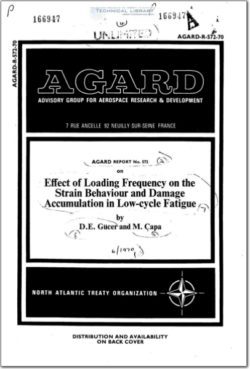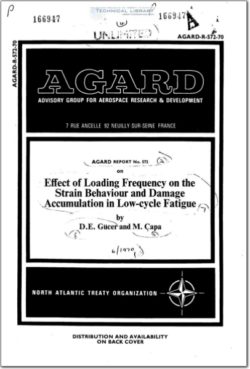AGARD-R-572-70

- Version
- 142 Downloads
- 8.86 MB File Size
- 1 File Count
- April 26, 2016 Create Date
- April 26, 2016 Last Updated
Effect of Loading Frequency on the Strain Behaviour and Damage Accumulation in Low-cycle Fatigue

Machine components and structuralmembers which fail by fatigue are nearly,always subjected to load changes
of varying frequencies. In practice these frequency changes range from thousands of cycles per minute down to
thousands of minutes per cycle. An understanding of the frequency effects in fatigue is not only important
because it may throw light on the basic mechanism or mechanisms of fatigue failure; but also because of the
need of the designer for such data in designing structures itself or in designing accelerated tests for
decreasing the testing time of these structures.
In recent years, attention has increasingly been drawn to this problem. However, most of the work has been
carried out in the range of frequencies of conventional fatigue machines, which is roughly 500 to 10,000 cycles
per minute (cm), and under loads giving long endurance lives. Under these conditions frequency effects have
been found to be small, usually of the order of a few percent. In the investigations above this range, a con-
tinuous increase in fatigue strength, with or without a maximum depending on the type of material and test
conditions, was observed. Below this range results are more conflicting and sometimes contradictory. Study
of existing information shows that- there is a need for extending the investigations to very low and very high
frequency regions. There appears that frequency effects originate from specimen heating due to high damping;
physical changes taking place in the structure of the material as a result of strain aging or other phenomena.
corrosive influence of air or other media, and finally from rheological effects related with strain rate or
creep. Reviews of literature dealing with the effect of frequency on fatigue have been given by Van Leeuwenl,
Forrestz, Stephensona, Bradshaw" and Weller.
The present investigation studies the frequency effects in the low-cycle fatigue field. Since endurance
lives in this field are below 10u or.105 cycles, machines with high frequency load application are not suitable.
Usually fatigue tests of axial, rotating bending or direct bending type are carried out at frequencies below
500 cpm. Existing information indicates that mechanism of failure in low cycle fatigue is,'most probably,
different from failure at long endurances, as evidenced from the appearance of the fracture surface which
resembles more that of the static tensile fracture than that of the typical fatigue fracture. Also at low
cycle fatigue endurance is more related to ductility6'7 and strain hardening capacitya, whereas high-cycle
fatigue is better correlated with tensile strength of the material.
| File | Action |
|---|---|
| AGARD-R-572-70 Effect of Loading Frequency on the Strain Behaviour and Damage Accumulation in Low-cycle Fatigue.pdf | Download |

Comment On This Post